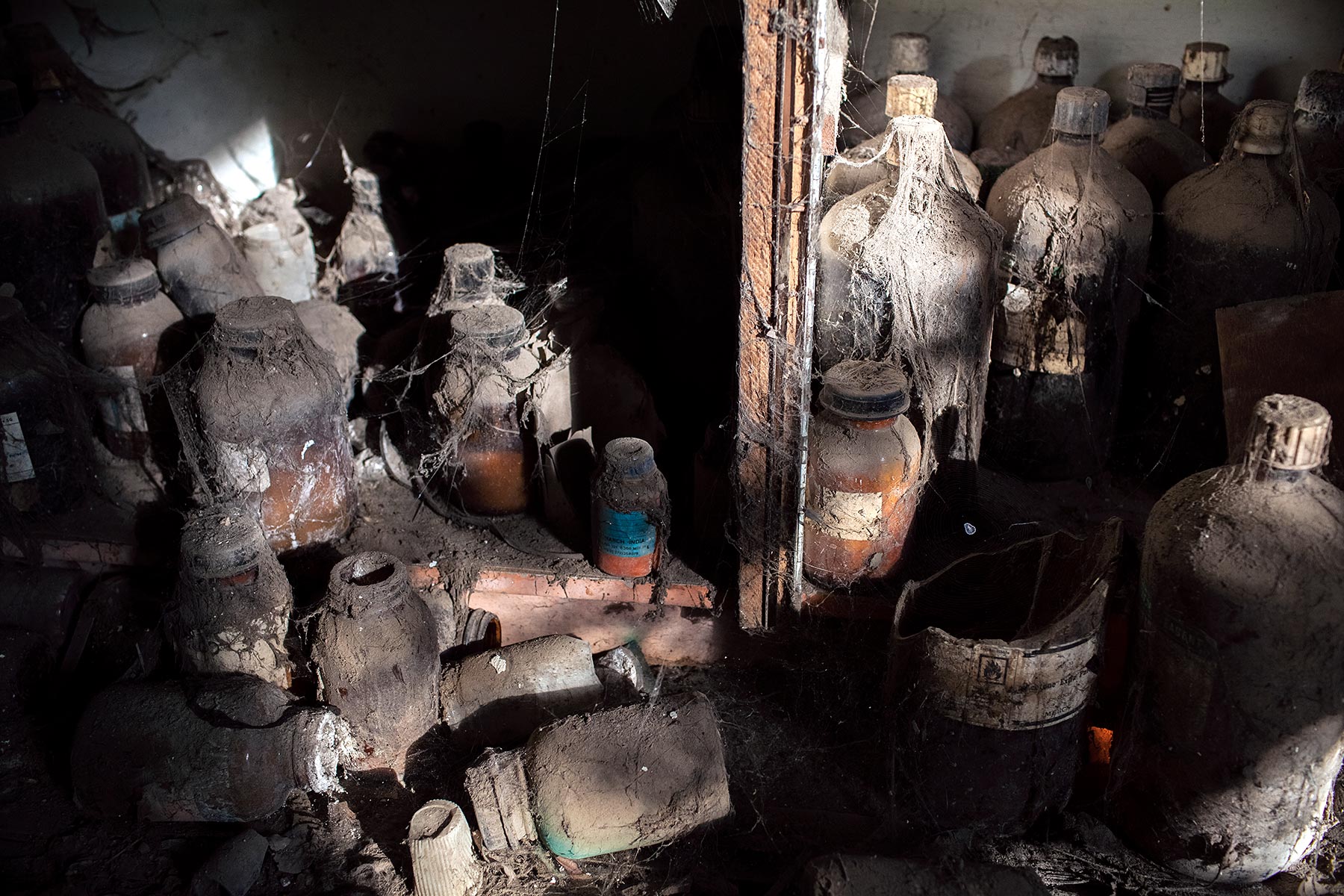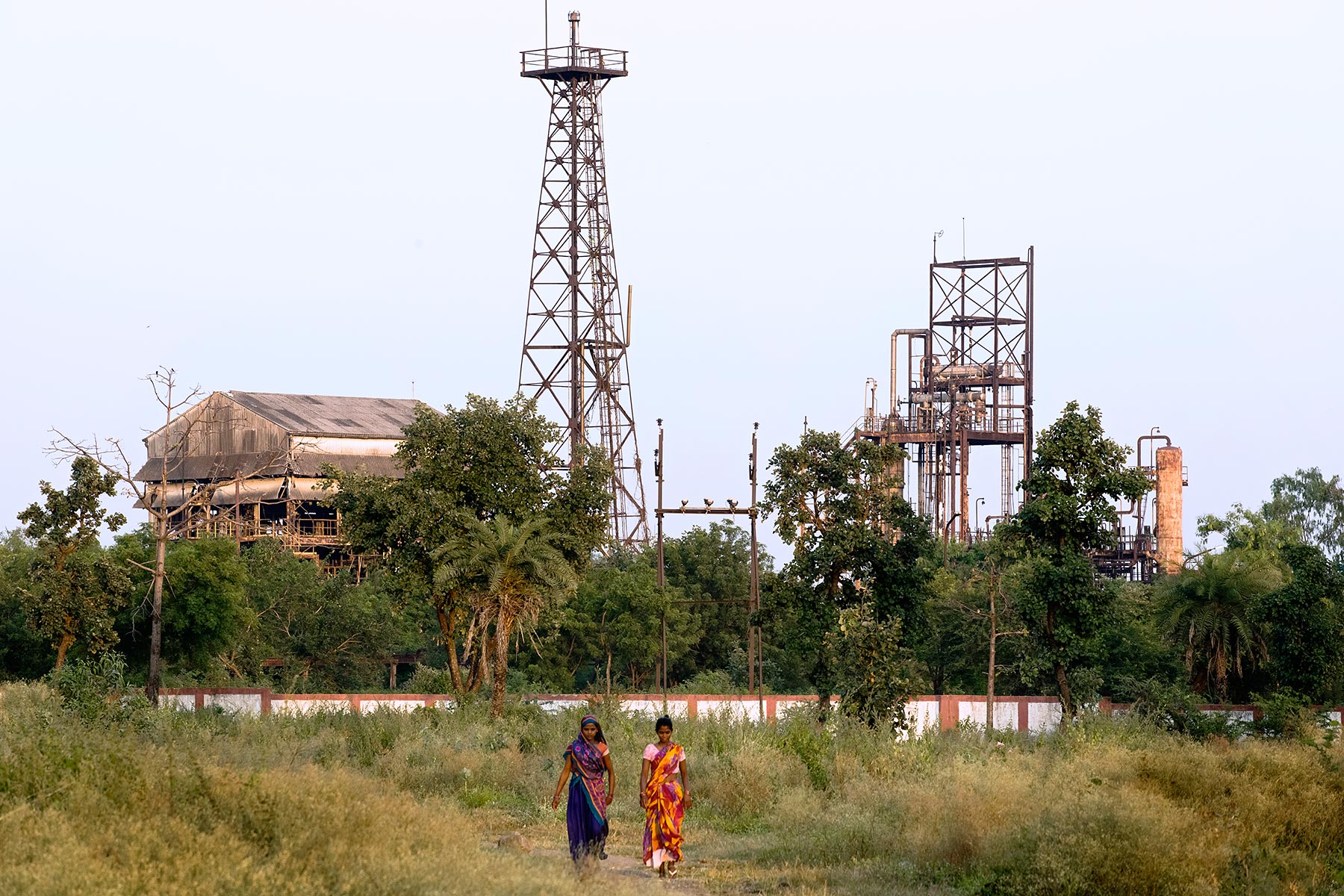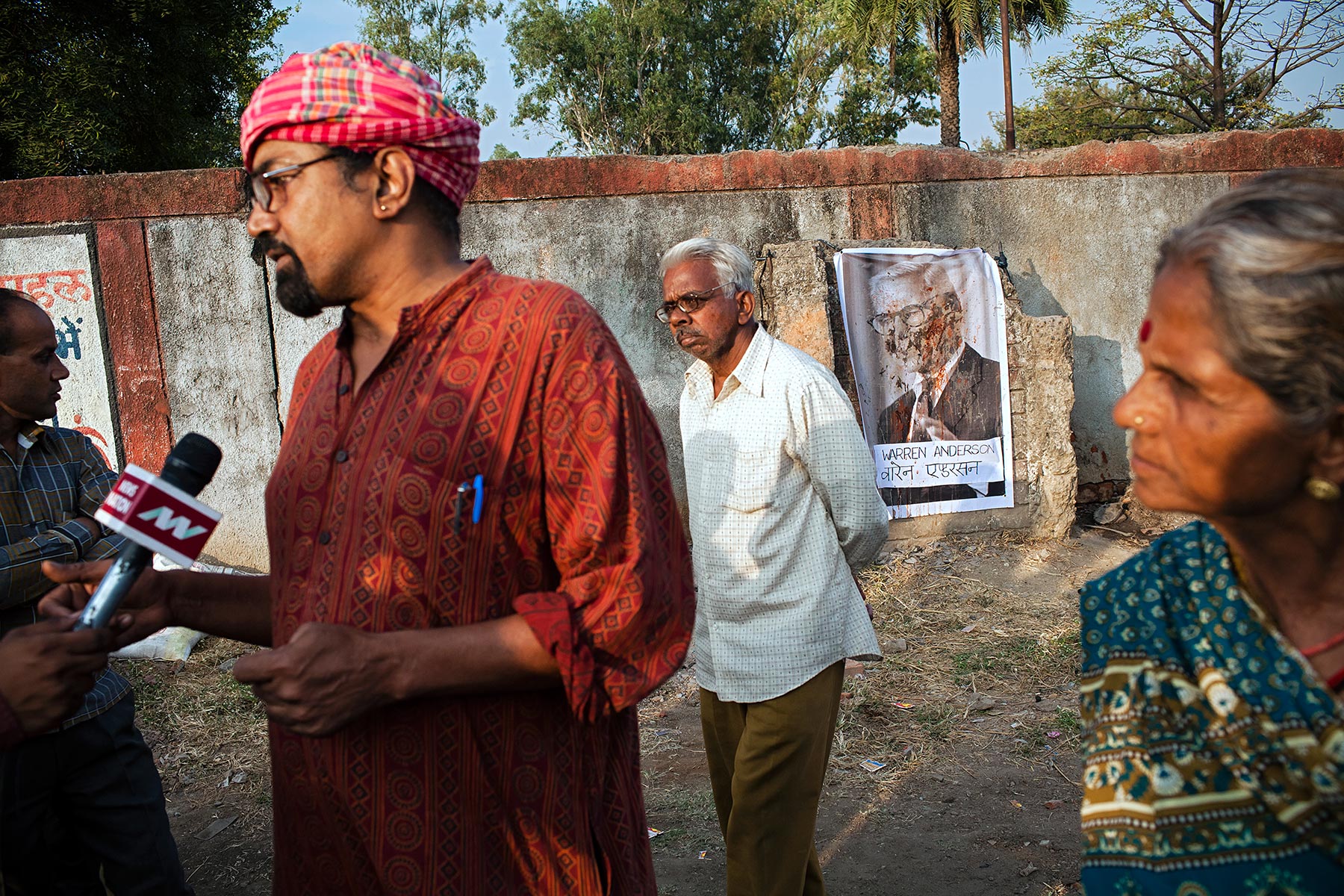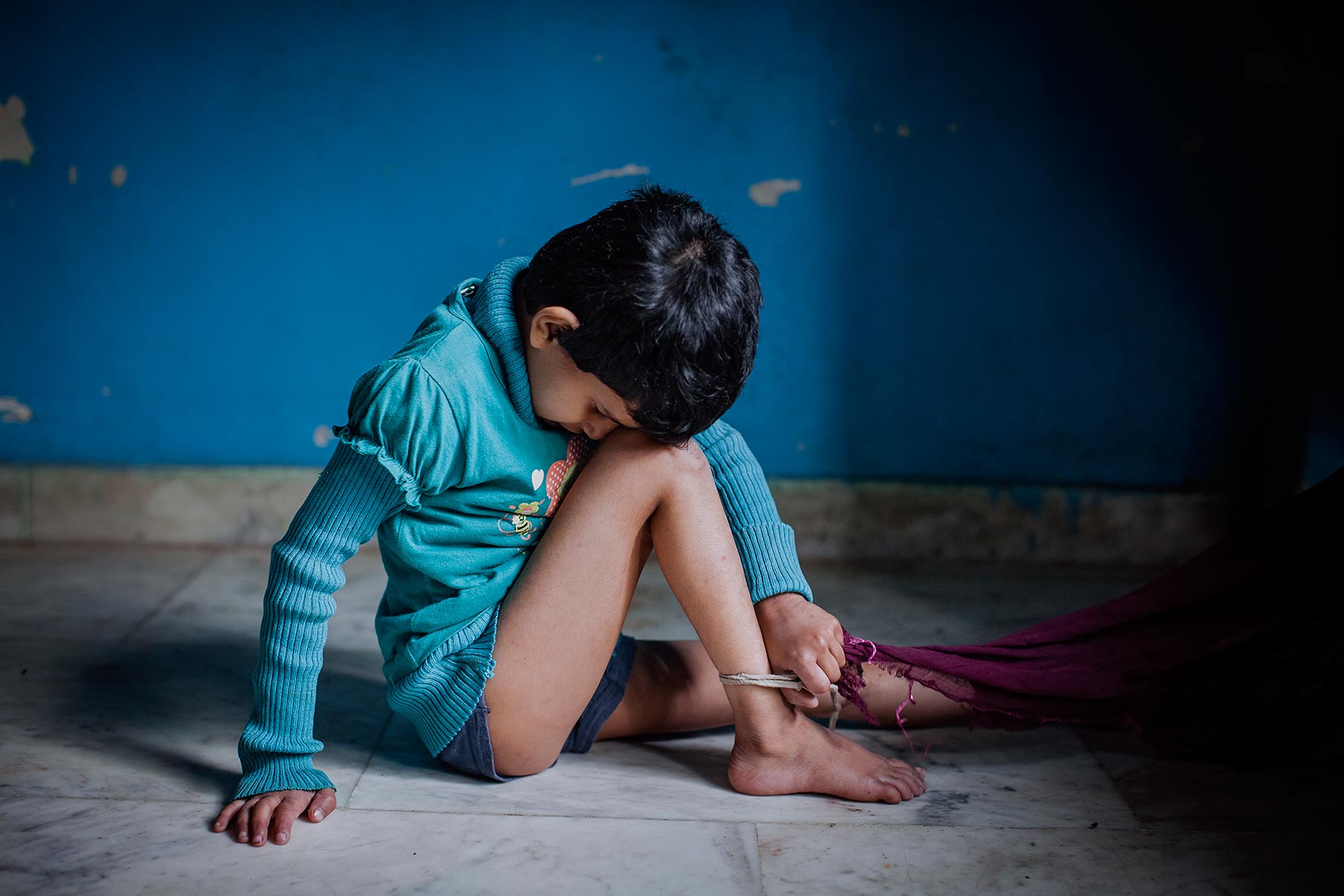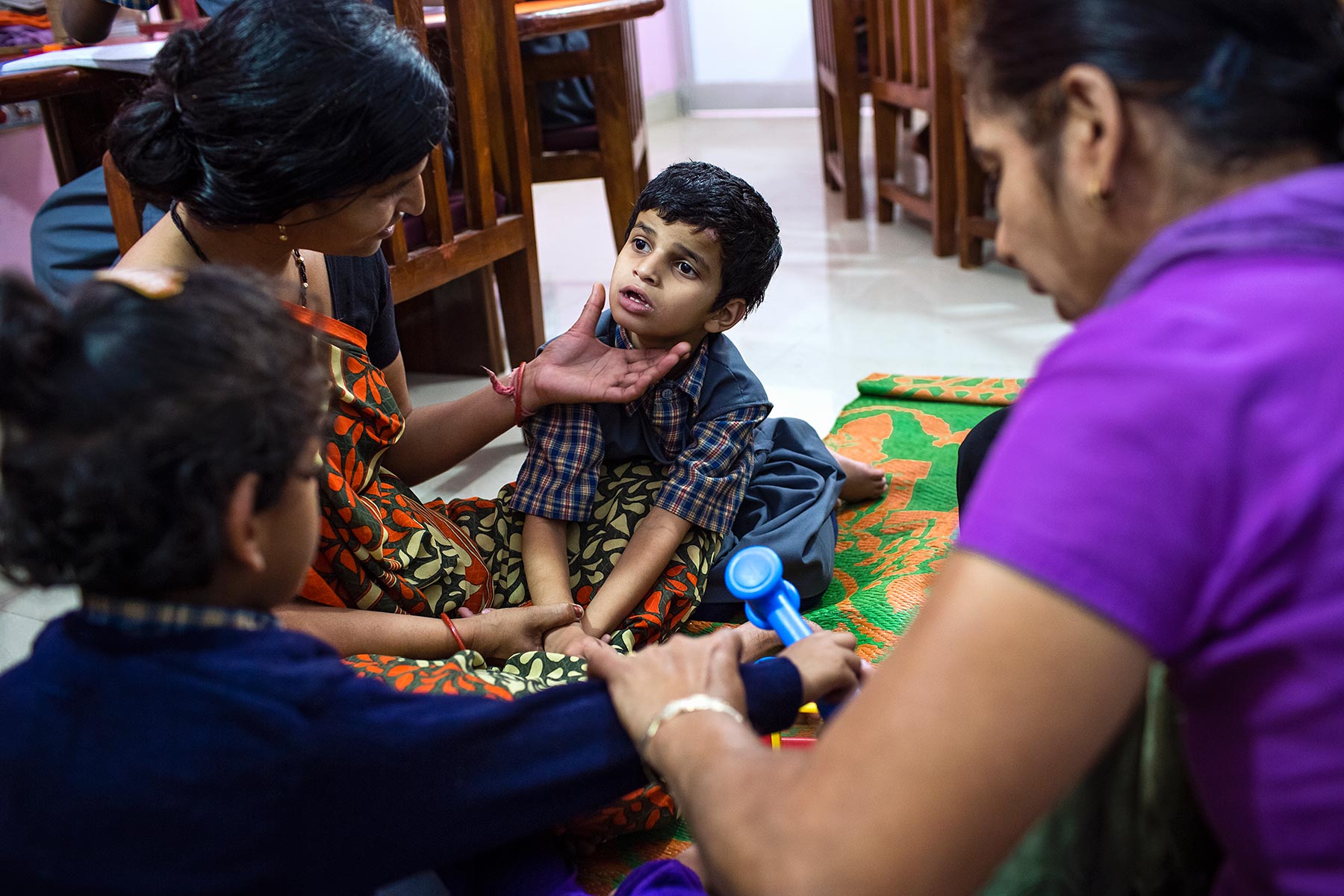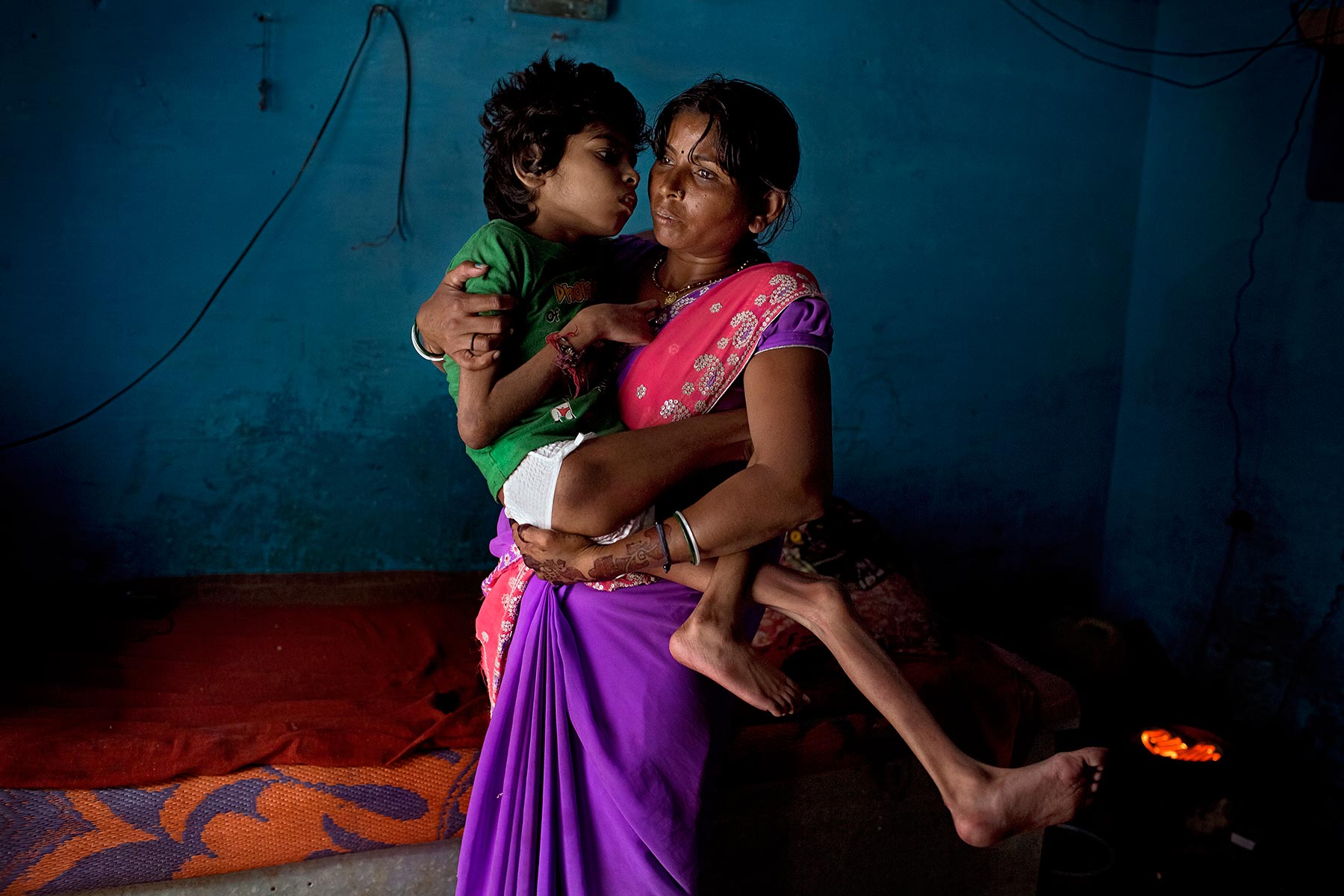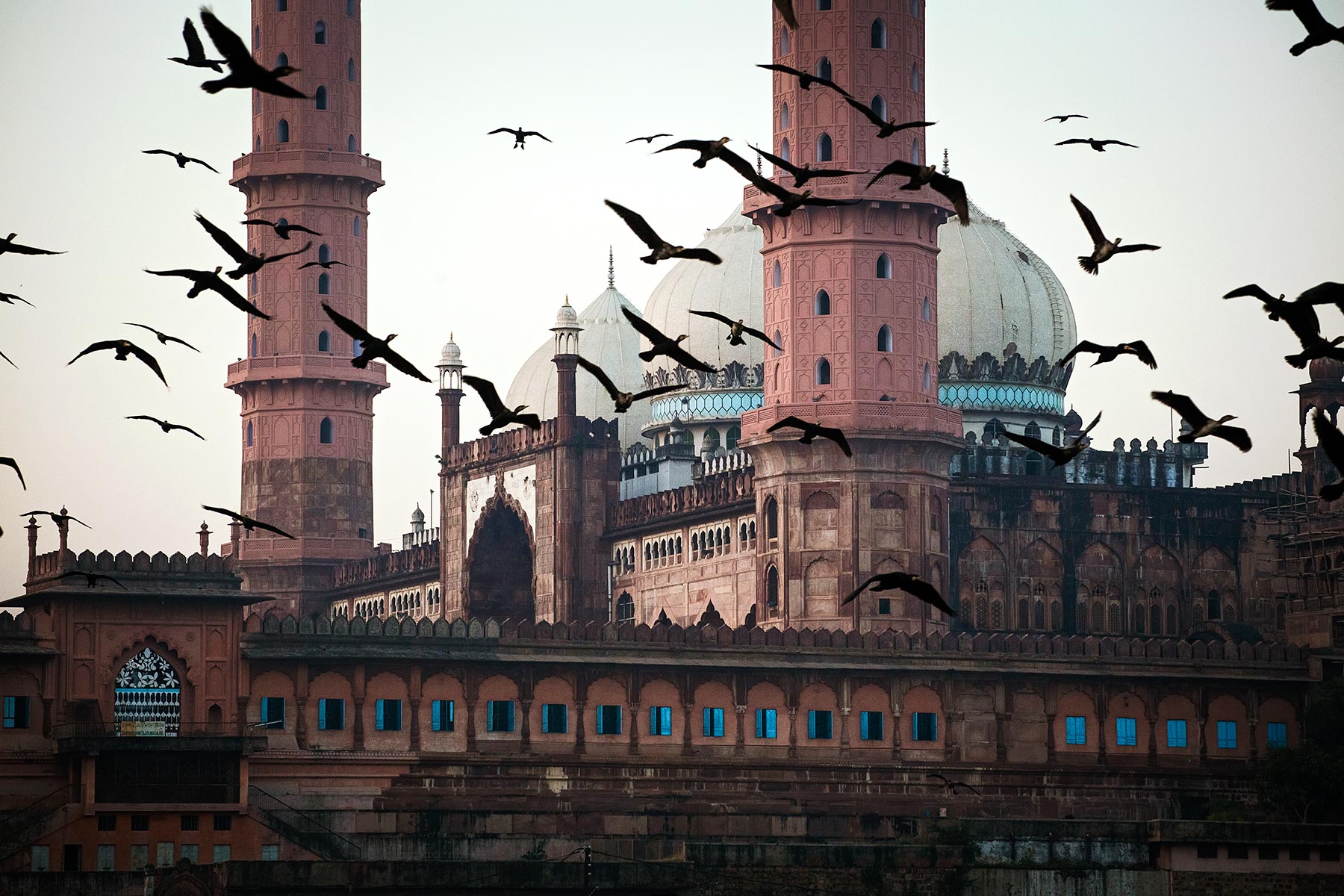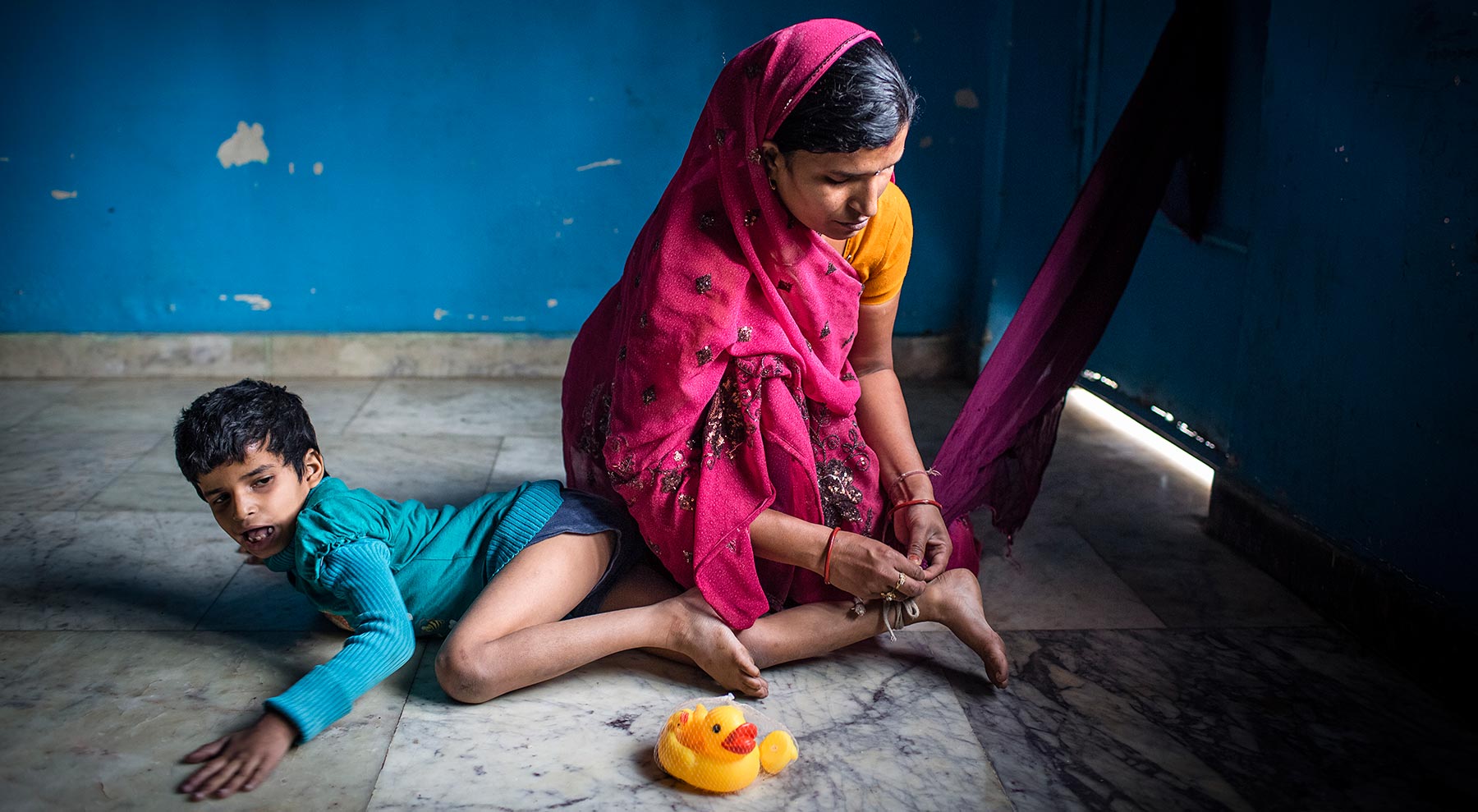
Bhopal: Tragedy lives on
30 years later, survivors of lethal gas leak still fight for justice
By Raksha Kumar for Al Jazeera America
Photos by Alex Masi for Al Jazeera America
Edited by Jayati Vora, Caroline Preston, Mark Rykoff
Rachi Yadav, 7, above, is stricken with microcephaly and myoclonic epilepsy. Her mother, Jyoti Yadav, who was exposed to the 1984 Bhopal Union Carbide chemical leak, uses a cord to prevent her daughter from injuring herself.
Published on Tuesday, December 2, 2014
Shezadi Bee lay on the pavement on a chilly day in central Delhi, less than a mile from India’s parliament building. Along with her fellow crusaders, the 59-year-old woman had been fasting for five days. In mid-November, more than 200 men and women from Bhopal, a city in central India, protested in the country's capital. Their demand: satisfactory compensation and rehabilitation for victims of the world’s worst industrial disaster.
Thirty years ago, a Union Carbide chemical factory began leaking 27 tons of the deadly gas methyl isocyanate, engulfing a large part of Bhopal’s old quarter and immediately killing more than 3,000 people. The city has never overcome its gory past. More than 150,000 people still suffer from cancer, tuberculosis and other serious diseases due to contaminated water and soil, according to nonprofits that work with the gas-leak victims, while children continue to be born with mental disabilities and epilepsy. The economic repercussions, such as a loss of productivity and jobs, have stalled the development of this once-thriving place.
“They mocked at our tragedy by handing us Rs 25,000 each [about $415]. Our only weapon against the mighty company and the government is a nonviolent fast,” says Bee. Her family’s list of ailments is long: Her husband has been afflicted with respiratory problems since breathing the gas, her son has tuberculosis, and she has cancer.
Union Carbide Corp., now a wholly owned subsidiary of Dow Chemical Co., says it has provided sufficient compensation and relief to the victims and survivors of the gas leak. In 1985, a year after the disaster, Union Carbide identified 94 percent of the approximately 500,000 victims as “being temporarily injured” and gave them roughly $415 each.
Four years later, as part of a settlement, the company agreed to pay $470 million to the Indian government. Union Carbide has said that, under the terms of the settlement, the government assumed responsibility for distributing the money and providing medical coverage to Bhopal residents in the event of future illnesses. Protesters, meanwhile, say that money was insufficient — just 15 percent of what the government initially sought — and only half of what the Indian Council for Medical Research, a public-health organization, said is necessary to rehabilitate survivors.
Even after three decades, the Bhopal disaster continues to cause public-relations problems for Dow, the world’s third-largest chemical company. Seven nonprofit groups have been organized to continue to fight the company, with financial and other support from 400,000 people in India and abroad.
“India is a very important market for Dow,” says Nityanand Jayaraman, an independent researcher and scientist. “They would do all they can to keep up their image and further their business interests in this country.”
Dow Chemicals declined interview requests for this article. In an email, however, Ruby Thapar, director of corporate affairs for Dow Chemical International Private Ltd. (Dow India) wrote that that it was the company’s “silent period and that we would not engage with the media.” In the past, Dow, which bought Union Carbide in 2001, has said that it is a separate company and bears no responsibility to clean up the waste it did not create.
Since 2001, Dow has spent millions on corporate philanthropy in India, efforts that have come under severe scrutiny. “Instead of cleaning up after themselves in Bhopal, Dow is trying to up its public image by some deliberate charity initiatives in other parts of the country,” says Safreen Khan, 19, a member of the group Children Against Dow Carbide. “This is like cutting a forest in one place and planting a few trees in another.”
In 2008, Safreen and six others demonstrated in the southern city of Chennai, outside a camp where free prosthetic limbs were being distributed as part of an event organized by Bhagwan Mahaveer Viklang Sahayata Samiti (BMVSS), a nonprofit organization that is the largest manufacturer of prosthetic limbs in the world. Since its founding in 1975, the charity has provided more than 1.3 million people with prosthetic limbs free of charge. When Dow began supporting the charity, Safreen and her friends urged BMVSS not to accept the funds. “Their money is tainted,” she says.
BMVSS disagrees. “We have hundreds of donors. Dow is just one,” says Bhupendra Raj Mehta, the organization’s joint secretary. Dow gives $150,000 every year to the nonprofit, he says, which amounts to approximately 12 percent of the group’s annual budget.
But Safreen’s criticism is not limited to cash donations. Dow is helping BMVSS develop a new polyurethane limb; until now, its prosthetics have been made from vulcanized rubber. On its website, Dow writes that the new limb is “durable, flexible and offers greater mobility.”
Activists, however, question the company’s motives. Relying on the plastic will make BMVSS dependent on Dow for raw materials, they argue. “Even if you consider this to be a regretful penance by Dow, it is not a sincere one at that,” says Jayaraman.
Protesters like Shezadi Bee are determined to challenge Dow’s image building. They have long argued that Union Carbide knew about the faulty tanks that had held the hazardous chemicals in the factory since 1982. But, they say, the company didn’t do anything to make repairs. Union Carbide denies this.
Around midnight on Dec. 2, 1984, Shezadi Bee, her husband and four children were awakened by a commotion outside their small shanty in the Blue Moon colony, near Carbide Road, which leads to the Bhopal plant. They ran outside, where they say they breathed the poisonous gas that was leaking from one of the faulty tanks in the Union Carbide facility.
“The thick, dark gas engulfed our neighborhood. We saw people running away from the factory. We ran with them,” says Bee. The family was lucky to flag down a truck leaving the city and managed to escape. But two neighbors who had also hitched a ride in the same truck died hours later after being unable to breathe. The Bee family escaped to a relatives’ house about 25 miles away and stayed there for more than a week.
Her husband’s respiratory problems keep him from performing the hard manual labor that once fed the family. Her son’s tuberculosis confines him to the bed “Even though we kept away from the factory for 10 days after the gas leak, we are still suffering.”
Occupied mostly by daily-wage laborers, the Blue Moon colony is a warren of homes built from mud, plastic sheets, rags and wood. Today, there is almost no one in the decrepit neighborhood who does not suffer from a chronic disease, according to local health workers with Sambhavna Trust.
“In the 14 years that the factory existed, it produced thousands of tons of poisonous waste. When the gas leaked and it became too big a case to handle, they dismantled the factory, dumped the waste in a pond nearby and left,” says Satinath Sarangi, founder of the Sambhavna Trust, which treats victims of the disaster. The Blue Moon colony is sandwiched by the erstwhile factory on one side and the infamous dumping pond on another. The factory was shut down immediately after the disaster.
In Qazi Camp, a neighborhood just over a mile from the factory, cows, goats and sheep are tied with ropes to the metallic gates and carts on either side of a winding street. Inside one home, of the Yadav family, in a room facing the street, their daughter, Rachi, 8, is tied to the door with rags and a rope.
“She can’t be let free,” says her mother, Jyoti. “She is hyperactive and hits herself with things or falls down from the bed if we do not keep her tied.”
Jyoti was only two when the gas leaked. She says she inhaled the gas that night and subsequently drank contaminated groundwater for several years. In 2006, she gave birth to Rachi, who is severely epileptic and suffers from a seizure disorder.
Rachi’s shrill voice pierces the empty room throughout the day. She spends most of her time trying to pull the rope off her leg, and on that rare occasion when she manages, she is promptly brought back to the spot and again tied to the door. The Yadavs are distraught over their daughter’s plight, but they say they have few options as they are poor and cannot afford medicine or to send her to a health facility.
According to Chingari Trust, a nonprofit that aids Bhopal victims, there are more than 740 children like Rachi who suffer from severe physical and mental disabilities as a result of the gas leak or subsequent water contamination. A 19-year study released in 2011 by the Indian Council of Medical Research found that the incidence of cancer among men living in gas-affected areas of Bhopal increased 115 percent for women between 1988 and 2007, and for men, 72 percent, compared with those living in areas not affected by the gas.
The toxic waste that activists say continues to seep from the factory and pond remains a big point of contention. Samples of water tested in 2009 by the Bhopal Medical Appeal, a nonprofit that works with the survivors, showed high levels of contamination. Dow says that, since the 1989 settlement, any responsibility for cleaning up the site has belonged to the government.
“If Dow Chemicals clean up in Bhopal, it would be an admission of their guilt,” says Rasheeda Bee, who helps run Chingari Trust. “They would rather provide safe drinking water elsewhere,” says Bee, referring to Dow’s corporate social-responsibility activities in other parts of the country that involve water purification.
In 2006, Dow installed water purification kiosks connected to a plant in two villages in the southern state of Andhra Pradesh. A reverse osmosis plant, which desalinates water, was designed to provide about 600 people in Dasaigudem village with clean drinking water. The plant uses membranes manufactured by Dow. Kiosks have been set up in the western state of Gujarat as well.
“The installation is all fine, but the maintenance of these kiosks is expensive. In that, the villages will be perpetually dependent on the membranes that they will be forced to buy from Dow,” says Jayaraman, the independent researcher. The groundwater in the villages is brackish, he says. The company could have ensured the safe disposal of industrial waste and improved environmental safety in the villages, he says, rather than simply treating the symptoms of unsafe water.
India’s chemical sector has grown by 13 to 14 percent in the last five years, according to a government report. India is also the largest market for the chemicals produced here.
“It is important to see how a tainted company like Dow returns to India after being accused of the worst industrial crime ever,” says Sarangi of Sambhavna Trust. “That clearly means that there is a nexus between the government and the chemical industry. This nexus makes it easier for the government and the company to transfer the responsibility to each other for crises like the gas leak.”
Bhopal victims continue to challenge Dow in courts. In 1991, the Supreme Court of India reinstated criminal charges against Union Carbide and eight of its employees. Since then, the courts in India have issued summons to Dow Chemical several times, unsuccessfully.
In 2004, the 2nd U.S. Circuit Court of Appeals ruled in a class-action lawsuit filed against Dow that the company could not be absolved of all responsibility for the disaster. Two years later, Bhopal victims petitioned the Indian government to increase the 1989 monetary compensation package by five times, citing inaccuracies in the number of dead and injured listed in the settlement. But in 2012, a separate appeal for monetary compensation from Dow was dismissed on several grounds by the U.S. courts.
Since 1984, Shezadi Bee and her friends have fasted three times to make their voices heard, but to no avail. The longest fast was for 21 days, three years ago, during the 27th anniversary of the tragedy. She says she will continue to challenge Dow’s attempts to bolster its public image.
“It is a dangerous precedent that Dow is setting through its [corporate social-responsibility] initiatives. It is sending out a message to other such companies that their negligence can cause disabilities in some children and maim them for life if they shell out some change to provide prosthetics to others,” she says. “Looks like several future generations will have to carry the fight forward.”
